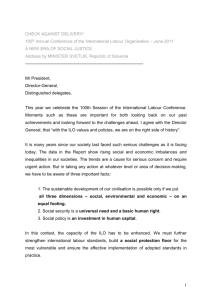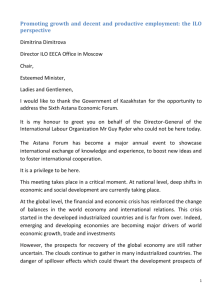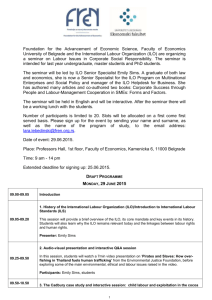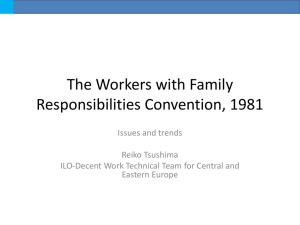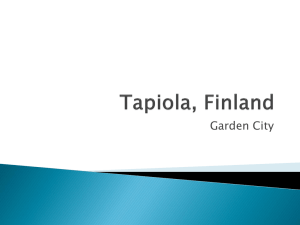European Identity and the European Social Model –
advertisement
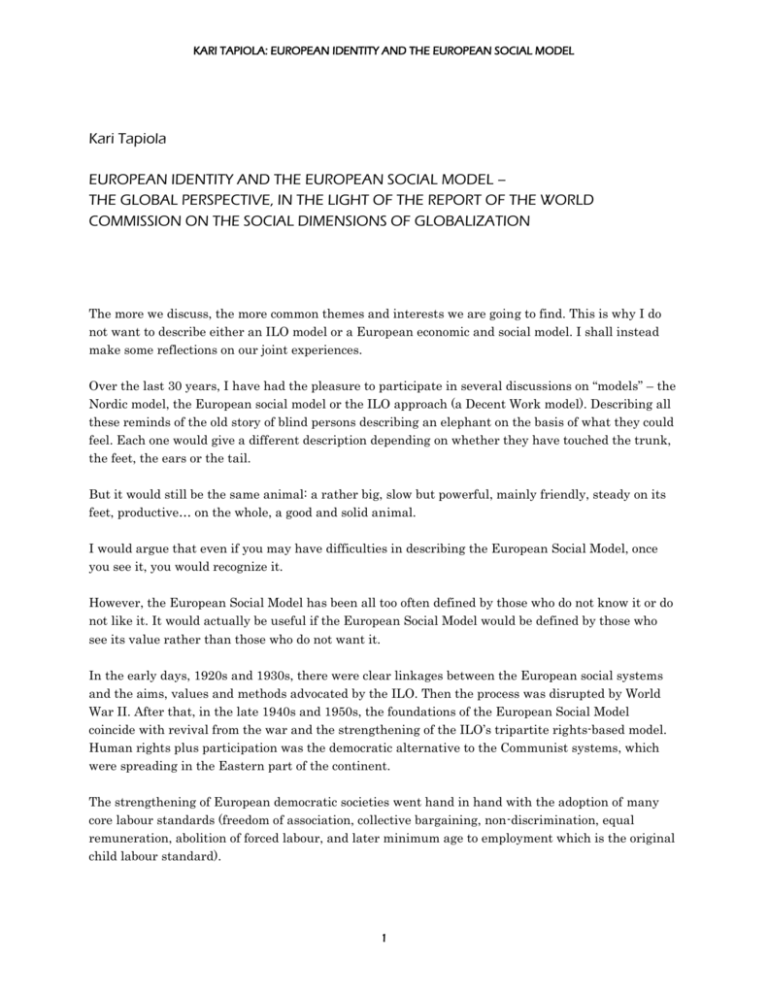
KARI TAPIOLA: EUROPEAN IDENTITY AND THE EUROPEAN SOCIAL MODEL Kari Tapiola EUROPEAN IDENTITY AND THE EUROPEAN SOCIAL MODEL – THE GLOBAL PERSPECTIVE, IN THE LIGHT OF THE REPORT OF THE WORLD COMMISSION ON THE SOCIAL DIMENSIONS OF GLOBALIZATION The more we discuss, the more common themes and interests we are going to find. This is why I do not want to describe either an ILO model or a European economic and social model. I shall instead make some reflections on our joint experiences. Over the last 30 years, I have had the pleasure to participate in several discussions on “models” – the Nordic model, the European social model or the ILO approach (a Decent Work model). Describing all these reminds of the old story of blind persons describing an elephant on the basis of what they could feel. Each one would give a different description depending on whether they have touched the trunk, the feet, the ears or the tail. But it would still be the same animal: a rather big, slow but powerful, mainly friendly, steady on its feet, productive… on the whole, a good and solid animal. I would argue that even if you may have difficulties in describing the European Social Model, once you see it, you would recognize it. However, the European Social Model has been all too often defined by those who do not know it or do not like it. It would actually be useful if the European Social Model would be defined by those who see its value rather than those who do not want it. In the early days, 1920s and 1930s, there were clear linkages between the European social systems and the aims, values and methods advocated by the ILO. Then the process was disrupted by World War II. After that, in the late 1940s and 1950s, the foundations of the European Social Model coincide with revival from the war and the strengthening of the ILO’s tripartite rights-based model. Human rights plus participation was the democratic alternative to the Communist systems, which were spreading in the Eastern part of the continent. The strengthening of European democratic societies went hand in hand with the adoption of many core labour standards (freedom of association, collective bargaining, non-discrimination, equal remuneration, abolition of forced labour, and later minimum age to employment which is the original child labour standard). 1 KARI TAPIOLA: EUROPEAN IDENTITY AND THE EUROPEAN SOCIAL MODEL Essentially this produced the Western European welfare model. There was an Eastern European welfare model, too. It was not based on shared fruits of growth but shared scarcity. Yet it delivered enough security for people to be able to generate some nostalgia up to this day. Once we were so solidly moving towards the European Social Model, an interesting question is: Why did we not live happily ever after? And why are we on the defensive now? Or why were we not on the offensive then? Or if, in fact, did we not realize that we were on the offensive – that we were pushing ahead then? The world did not remain the same. It was not, after all, on a steady growth path towards a universal middle class. One of the illusions was that as such, the model could be transferred to the former colonies which became “the developing world”. Maybe this took place to some extent in the formal sector, but not in the economy as a whole without other significant impulses to growth (and they were few and far between). This is something that the ILO has certainly suffered more from than Europe. It has taken us time to start coming to grips with the informal economy or with the large areas of poverty and significant inequality in incomes and growth. And yet, our biggest technical cooperation programme is a standards-based programme which is solidly in the informal economy: the child labour programme, IPEC. The European Social Model was not an integral part of the development of the European Communities before the internal market and a significant process of enlargement. The fate of social models and reforms seems to be that they always have to be developed under political and economic pressure rather than as an integrated part of a coherent policy. In the European case, popular acceptance of the internal market had to be generated; acceptance for enlargement was needed; and maybe – in due time – more of the social will help in getting through a Constitution, too. There is nothing new in using “social” measures for economic and other efficiency purposes. After all, one of the motives of the early and more stringent child labour laws in Prussia in the 1830s was the desire of the military to have healthy recruits for the army. Neither are attacks on the European Social Model new. In the late 1970s and early 1980s, they surfaced in the debate on labour market flexibility. “Flexibility” is a good word which was hijacked in the OECD by a growing conservative or neo-liberal trend. Those who went through the flexibility battles in the OECD may remember that in 1980, the two alternative words offered for the debate were “malleability” and “pliability”. And yet, also in the OECD, in the 1980s, a report on labour market flexibility came – not surprisingly – to some important conclusions. It noted that flexibility had to be negotiated; it was not a unilateral weapon of one group against another; and you need standards against which flexibility is possible. Flexibility without a standards-based framework is simply chaos. 2 KARI TAPIOLA: EUROPEAN IDENTITY AND THE EUROPEAN SOCIAL MODEL Now all of us can today ask, how well were these authoritative conclusions followed up in later years. And how prepared were we – the ILO or what today is the European Union – for the attack on standards and tripartite cooperation after the Communist systems collapsed and the world trade system started being opened up? It took us some years to realize that the new universal market did not by itself deliver growth and happiness for all. Hence the whole debate on first trade and labour standards and then the social dimensions of globalization. This strengthened the drive for a more coherent approach to promoting employment, rights, social protection and social dialogue: the Decent Work approach. It also strengthened the call for globalization that is fair, as outlined by the World Commission on the Social Dimensions of Globalization (2004). This World Commission was co-chaired by the Presidents of Finland and Tanzania. One of them (I shall let you conclude which one) said at the outset two things. One: to be worthwhile, this exercise must also strengthen the European Social Model. And two: this exercise has to strengthen the responsibilities of the state in the field of social policy. These responsibilities cannot be abandoned because the measures to deal with the effects of globalization start at home. International measures can strengthen but not replace them. The ILO and the European Union are in this together. Social justice, standards and social dialogue are our shared values. If they do not work in Europe, it is difficult to make them work globally. And if they do not work globally, it is all the more difficult to make them work in Europe. ► Kari Tapiola is Executive Director of the International Labour Organization 3
